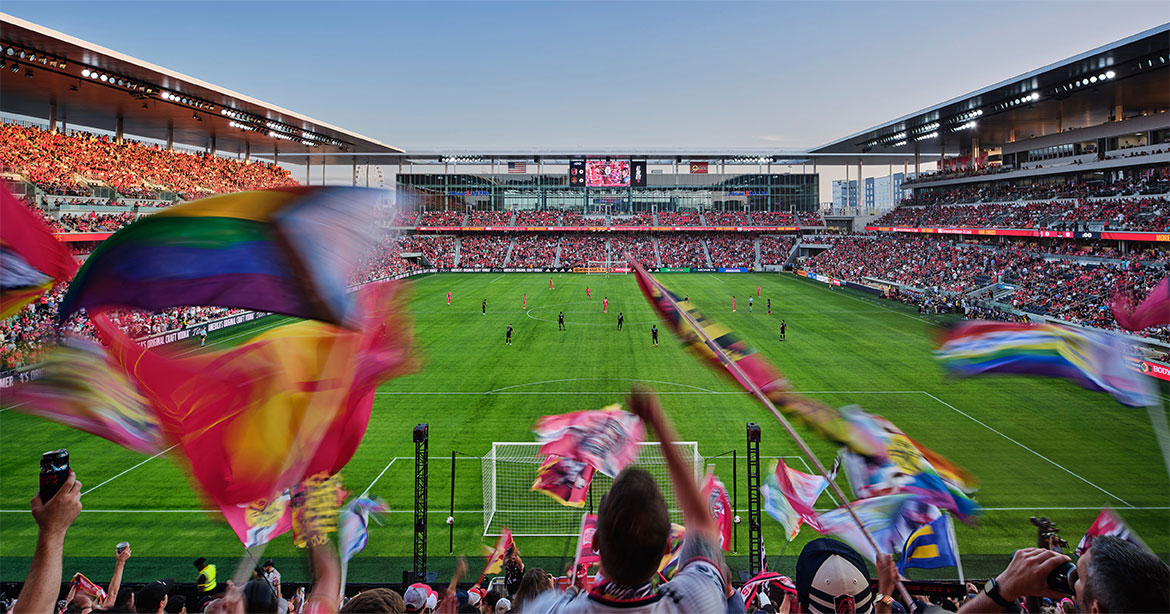
Read time: 7.5 minutes
CITYPARK was born out of a compelling need and bold vision: to create a soccer hub that seamlessly blends into a thriving new downtown district, creates an unparalleled fan experience, and provides the best of the best for players and the next generation of greats.
The 22,500-seat stadium is the centerpiece of CITYPARK District, America’s largest urban professional sports campus. The first of its kind, this hub combines St. Louis CITY SC’s headquarters, training facility and practice fields in a centralized location among a new mixed-use district.
From its inception, exceeding expectations was the campus’ north star – a guiding principle of the club’s primary owners, the Taylor family. Through an unwavering commitment to intentionality in the venue’s design, construction and day-to-day operations, CITYPARK fulfills their mission: a stadium exceptionally built with exceptional purpose.
Community at The Core
People are at the heart of CITYPARK.
The stadium’s location was a strategic choice by the ownership team, who have 100 percent local roots in St. Louis business, philanthropy and soccer. CITYPARK sits on Market Street, a main thoroughfare uniting some of St. Louis’ most iconic institutions with the Gateway Arch monument. This location not only complements the existing liveliness of the street – where community events are abundant – but also allows the stadium to contribute to a larger urban redevelopment initiative. CITYPARK has played a pivotal role in attracting new visitors and bringing year-round business to the area. Since the team’s expansion announcement in 2019, over 600 new permits have been issued with nearly $850 million of new investment in St. Louis’ Downtown West neighborhood.
The stadium’s architecture was established with this community-first mindset. Contrary to the standard inward-facing MLS venues, which seclude fans from their surroundings, the architecture of CITYPARK welcomes visitors in from every angle. The venue’s open-air corners allow passersby to see straight into the bowl, a visual commitment to inclusivity.

Constructing a 360-degree building presents unique challenges, including where to incorporate the essential back-of-house infrastructure. “The goal was to not turn our back to any side of the city,” said Erik Thomas, design phase executive with Mortenson. “Our solution was to hide the loading dock and dumpsters underground, accessible via a ramp under Market Street, so when you look at the stadium, all you see are front doors.”
The community-oriented details of the facility transcend the stadium’s walls. Improving the public amenities outside of the stadium was a top priority. This was achieved by incorporating pedestrian-centric green and gathering spaces to continue the Brickline greenway from downtown St. Louis. “The team wanted the 125,000-square-foot plaza to the east of the stadium to be a community asset,” said Thomas. “Since the plaza hosts gameday activities, public festivals, and other events year-round, it was important the stadium’s eastside bathrooms and gates would be operational outside of matchdays.”
The Pillars of the Valley art exhibit (left) and curated pathways provide significant space to honor the past and inspire connection – as seen in the “March to the Match” parade (right).
Women Leading in the Field
As the first majority female-owned club in MLS history, breaking barriers is signature to the spirit of the club.
Complementary to the club’s ownership, women occupied strategic roles throughout design and construction. “Female leadership in sports and construction has historically been few and far between,” said Spangler. “Representation is rising in both industries and it’s great to see.”
Madelin Cowden was promoted to superintendent while working on CITYPARK, overseeing the construction of the stadium’s Hellcat Pub and CITY Pavilion – an adjacent, stand-alone building home to the official team store, a café and second-floor space open for events and conferences. “With so many strong female leaders around me, I never questioned if I was going in the right direction as a female in the field,” said Madelin.
Tastefully St. Louis
Intentionality is even baked into CITYPARK’s concessions, which explains why their roster includes a “Flavor Officer,” a title you don’t see on your average sports team. To celebrate St. Louis’ diverse culinary scene and achieve their goal of having the best matchday menu in sports, CITY SC appointed local chef, restaurateur and James Beard Award winner Gerard Craft to oversee the stadium’s food program, CITY Flavor.
The 100 percent local in-stadium program, a unique accomplishment for a sports venue, focuses on empowering local restaurants both within and beyond the stadium. Ahead of the first kickoff, the construction team closely collaborated with each food vendor to ensure they had the necessary kitchen set up to deliver their best from day one – demonstrating that these restaurants were a priority and not an afterthought.
Over the 2023 season, CITY Flavor drove over $3.5 million in revenue for its food partners, according to the team’s website. This was uncovered in a postseason survey, highlighting that more than half of fans visited brick-and-mortars after eating at a restaurant inside CITYPARK.
A Distinct Homefield Advantage
The St. Louis CITY SC’S 2023 debut season was record-breaking.
- Most wins by an MLS expansion club
- First expansion team in MLS history to win their conference in their inaugural season
- One of four expansion teams to score 60 or more goals in their debut season
- Tied for first in the most different goal scorers for an expansion team in MLS history
The backbone of their success? A home base to support their victories.
CITY SC’s home field provides more than most. Centralizing all facilities on a single campus, the largest of its kind in the country, streamlines and improves the player experience. The 28,000-square-foot training facility features a weight and cardio room, locker rooms, a player lounge, a deluxe film room, team dining space, hydrotherapy and cryotherapy. Garage doors create an effortless transition from the facility to the practice fields, which include two grass pitches and an artificial pitch to support year-round amateur and professional training programs. This state-of-the-art campus supports the team’s ambition to create the continent’s premier soccer academy and development system.
An Unmatched Fan Experience
How do you provide the best fan experience possible? You deeply understand your fans. Everything from the structural steel down to the line at the concession stands were developed with CITY SC fans top of mind. “A ton of focus was put in by the team to understand what’s important to each fan and ensure they had access to the amenities they need,” said Spangler.
In the design and construction process, fan sightlines, circulation and engagement touch points were priorities embedded throughout CITYPARK.
Some key components that were truly built for the fans:
The Canopy
Canopies are a significant architectural feature of MLS stadiums, and CITY SC wanted their canopy to bolster the fan experience and marry design with functionality.
The 360-degree metal canopy was designed for noise amplification and fan comfort. While the stadium has an open-air feel, the canopy reverberates the sound to create a booming homefield advantage, intimidating opposing teams and emboldening supporters.
The canopy also provides 80 percent seating bowl coverage to shelter from the variety of weather elements. Aesthetically, it is sleek and sophisticated, with solid metal paneling along the underside, mirroring the Gateway Arch’s reflective nature, improving acoustics, and hiding top-of-house wiring.
The Bowl
The bowl provides an intimate fan experience at every price point, including general seating areas, the fanatic supporters’ club, in addition to diverse premium offerings.
Reinforcing the pedestrian-friendliness of the stadium, the pitch sits 40 feet below street level. This decision, made during design, brings all fans closer to the game and has resulted in no seat being more than 120 feet from the pitch, with the closest seat only 15 feet from the touchline.
The Technology
The stadium’s intricate low-voltage infrastructure seamlessly connects systems across the 32-acre campus, resulting in digital efficiencies, reliable connectivity, and an uninterrupted fan experience during matches.
From cutting-edge screening technology that allows 500 fans to enter the stadium per minute to the 375 TVs, three large video walls, two primary video scoreboards, and 360-degree in-stadium ribbon boards throughout the bowl and concourse, CITY SC made strategic investments to ensure fans never miss the action on the field.
The App
To achieve a frictionless fan experience at CITYPARK, the team has gone 100 percent digital, leveraging the custom-built STL CITY SC mobile app. “We wanted to build something for the future, and that meant putting technology at the center of everything we do,” explained St. Louis CITY SC’s Chief Experience Officer Matt Sebek.
In this app, fans can purchase and store their tickets, order food from their seats, view personalized itineraries, and access exclusive content. These features reduce concession lines, increase convenience-driven revenue, and create more team/fan interactivity.
CITYPARK stands as a testament to visionary thinking and embodiment of excellence. Chock full of superlatives, this stadium creates one-of-a-kind fan and player experiences and brings the best of St. Louis to the forefront.









